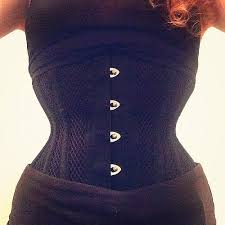
The Kardashians and other celebs are spruiking waist trainers - in particular the ones designed for exercising. Put them on and you’ll speed up the weight-losing, body-sculpting benefits of exercise.
The advertising spiel around, what are essentially resurrected, re-branded, 19th century corsets, tells you you’ll achieve “a slimmer waist faster than usual”. Can’t argue with that. That's the idea of squeezing into a corset.
But there are other claims you can argue against: For example, if you wear them every day for an extended period: 1. you'll lose weight, 2. your pre-baby body shape will be restored quicker and 3. you’ll have better posture.
Let’s look into these claims.
1. Lose weight?
The only way to lose weight is to take in less energy than you expend. Considering waist trainers push the stomach high up into the chest cavity, resulting in a squashed stomach (and heartburn, evidently), perhaps you do lose weight. Your stomach is so severely restricted, it can take in only a tiny amount of food each time you eat.
2. Restore your pre-baby body quicker?
This sounds highly unlikely. The work of the abdominal muscles (that would otherwise have been holding in the tummy) has been done by the waist trainer for weeks and weeks. These muscles’ condition will have deteriorated - atrophied, in fact. If anything, you’ll have softer, floppier tummy muscles after wearing one of these.
3. Give you better posture?
Again, good posture relies heavily on the strength of the core muscle group supporting the spine. These muscles are incredibly important for buttressing and protecting the spine from injury. Just like the abdominal muscles, these muscles are idle because the waist trainer is doing all the work. Letting these muscles weaken like this is likely to, in fact, worsen posture and increase the risk of back problems.
Apart from these dubious claims, waist trainers actually have the potential to do harm to your body - in particular, the pelvic floor (the sling-shaped group of muscles and ligaments holding up the uterus, bladder and bowel, and closing off the urinary and anal sphincters). The ongoing squeezing in of the abdomen pushes the diaphragm up high into the chest cavity and the pelvic floor down low into the pelvis.
This constant downward pressure strains and stretches the pelvic floor, eventually weakening it if isn’t strong enough to withstand these added pressures. Any additional pressure as the result of exercise only exacerbates the problem. A weakened pelvic floor makes a woman more susceptible to incontinence problems and prolapse.
There are no shortcuts to weight loss, a sculpted body and good posture. A healthy diet and regular daily exercise, incorporating core and pelvic floor-strengthening exercises, are fundamental to achieving these. They’re also vital for good, overall general health.
The Continence Foundation of Australia strongly advises women, before rushing in to a buy a waist trainer, to have a word to a pelvic floor-trained fitness professional, a physiotherapist, continence nurse, or other medical professional about their usefulness.
If you or someone you care for is experiencing incontinence or other pelvic floor problems, contact the National Continence Helpline (1800 33 00 66).

